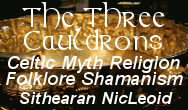Ariadne's Tribe: Minoan Spirituality for the Modern World
Walk the sacred labyrinth with Ariadne, the Minotaur, the Great Mothers, Dionysus, and the rest of the Minoan family of deities. Ariadne's Tribe is an independent spiritual tradition that brings the deities of the ancient Minoans alive in the modern world. We're a revivalist tradition, not a reconstructionist one. We rely heavily on shared gnosis and the practical realities of Paganism in the modern world. Ariadne's thread reaches across the millennia to connect us with the divine. Will you follow where it leads?
Find out all about Ariadne's Tribe at ariadnestribe.com. We're an inclusive, welcoming tradition, open to all who share our love for the Minoan deities and respect for our fellow human beings.
Lilies: The Quintessential Minoan Flower
When you mention the phrase "Minoan flower," most people immediately think of lilies. Yes, the saffron crocus was very important to the Minoans - in their religion, their art, and their economy - but somehow lilies have taken the spotlight. And with good reason.
They're beautiful, for one thing. Just look at that image above! It's a portion of the Spring fresco from Akrotiri, showing a typical springtime scene of red lilies blooming and swallows returning from their winter migration to Africa. These are probably wild Turk's cap lilies (Lilium martagon) which are native to the Mediterranean.
When they're shown in color, lilies appear in two colors in Minoan art: red, like the ones above, and white. The white ones may very well be Lilium candidum, known today as Madonna lily and also native to the Mediterranean.
Here's another depiction of lilies, from the fresco in the Minoan villa in Amnisos. This style is called light-on-dark, with white lilies against a deep red background:
Like the Spring fresco above, this is a naturalistic depiction of lilies. This one is meant to make the room look like it's a garden even though it's indoors.
The same color scheme appears on this pithos from Akrotiri:
It's hard to tell from the photo, but the pithos was originally dark red. The individual flowers are fairly realistic, but they're used as an allover design rather than in a natural-looking setting.
They can also appear in a much more stylized design, like on the lid of this strainer from Stavromenos:
The double-curl of the lily as depicted in Minoan art suggests breast imagery - at least, that's how we interpret it in Ariadne's Tribe. So that's a connection with the Mother Goddesses, including Rhea.
But we also associate the lily with the goddess Ariadne. The Mysteries reflect her yearly schedule: She spends the summer (the "dead time" in the Mediterranean) in the Underworld, then returns to the World Above - our world - when the rains begin in the autumn and the first green sprouts spring up in the fields.
So Ariadne has two faces, the Underworld and the World Above. We associate red lilies with her Underworld face, red being the color of the dead. And we associate white lilies with her time in the World Above, white being the color of light but also of the grain crop that she embodies. The red-and-white pairing with lilies is related to, but not exactly the same as, the red-and-white pairing of skin colors in Minoan art.
Lilies come in a wide variety of colors these days, and may have done so in the ancient Mediterranean as well. But the red and white ones have a special place in Minoan art and Tribe spirituality.
Comments
-
Please login first in order for you to submit comments























